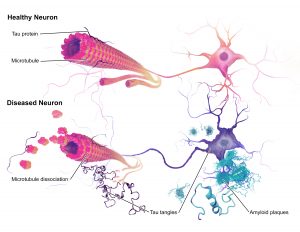With winter rapidly approaching, I woke up to my grandpa pulling out his mittens and snow shoes for his daily walk.
Why? Regular physical exercise has been shown to lower the risk of Alzheimer’s. This frightening disease affects over 500,000 Canadians, with associated costs of $10.4 billion a year!
What is Alzheimer’s?
Have you heard of people forgetting their children and spouses? Memory loss is one of the main symptoms of dementia (symptoms caused by brain disorders). One of the main causes of dementia is Alzheimer’s. Although most people with Alzheimer’s are over age 65, it is not a normal process of aging. It is a disease that gets worse overtime, eventually causing severe dementia symptoms affecting daily life. Often times this means hiring an expensive full-time caretaker.

Video explaining Alzheimer’s in more depth. Credit: TED-ED
What Causes Alzheimer’s?

Comparison of a health neuron in contrast to a neuron affected by plaques and tangles.
Credit: Wikimedia Commons
Alzheimer’s disease makes two abnormal structures in the brain called plaques and tangles. The plaques and tangles develop in the brain, which eventually damages and kills brain cells leading to dementia symptoms. Unfortunately, there is no cure for Alzheimer’s currently, but early diagnosis and treatment can slow down progression.
How can Eye Exams Diagnose Alzheimer’s?
An eye exam with an ophthalmologist (an eye specialist) has two parts. The first part of the exam involves taking scans of the back of the eye called the retina. The second part is where the ophthalmologist looks into your eye for any diagnosis of eye diseases. Recent research has shown that both portions of the exam can give early warning signs of Alzheimer’s.
Scanning the Back of the Eye
Optical coherence tomographic angiography (OCTA) is a large part of an eye exam. It is a technique used to scan the retina. By examining this detailed scan, ophthalmologists can possibly predict people with symptoms of Alzheimer’s.

Retinal scan taken with Optical Coherence Tomography
Credit: Wikimedia Commons
Eye Diseases Increase the Chance of Diagnosing Alzheimer’s
Then in the exam room, the ophthalmologist will further examine the retina and other parts of the eye. This will allow the doctor to diagnosis eye conditions, such as macular degeneration, glaucoma and diabetic retinopathy. These are all degenerative diseases, meaning they get worse overtime. There is a positive link between degenerative eye conditions and brain health which will allow physicians to possibly diagnose Alzheimer’s.
What Does this Mean for the Future?
On the market right now are inefficient and expensive Alzheimer’s screening techniques, thus diagnosis is reliant on behavioural changes. However, these symptoms usually appear a while after disease onset. Therefore, if retinal scans can be used, it would be an effective and cheap screening solution. It is hopeful that yearly eye exams will allow for disease diagnosis and early treatment. So, if you know anyone over the age of 40, try recommending an eye exam to them!
